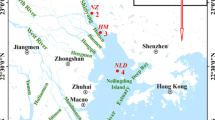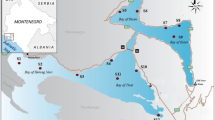Abstract
Metal concentrations in a sediment core from a moat outside Osaka Castle in Japan were measured by ICP-MS following a microwave extraction method. Concentrations of metals in the sediment core samples peaked around 1945 when the World War II ended. This is in part due to great air raids on Osaka. In cluster analysis using metal concentrations, the fractions of sediment core samples were classified into two groups, representing natural sources (1795–1915) and anthropogenic sources (1922–1976), respectively. Results of lead isotope ratios also showed the anthropogenic influences from 1915 by changing the ratio values compared to those of natural sources. In addition, several components contributing to metal concentrations were identified by principal component analysis. The main component was controlled by natural sources and a decrease of the component score corresponded to an increased influence from anthropogenic sources. The largest impact of anthropogenic sources was shown around 1945.







Similar content being viewed by others
References
Amiard, J., Bacheley, H., Barillé, A., Barillé, L., Geffard, A., & Himery, N. (2004). Temporal changes in nickel and vanadium concentrations and in condition index and metallothionein levels in three species of molluscs following the “Erika” oil spill. Aquatic Living Resources, 17(3), 281–288. doi:10.1051/alr:2004037.
Audry, S., Schäfer, J., Blanc, G., & Jouanneau, J. (2004). Fifty-year sedimentary record of heavy metal pollution (Cd, Zn, Cu, Pb) in the Lot River reservoirs (France). Environmental Pollution, 132, 413–426. doi:10.1016/j.envpol.2004.05.025.
Bollhöfer, A., & Rosman, K. J. R. (2001). Isotopic source signatures for atmospheric lead: the Northern Hemisphere. Geochimica et Cosmochimica Acta, 65, 1727–1740. doi:10.1016/S0016-7037(00)00630-X.
Chiffoleau, J., Chauvaud, L., Amouroux, D., Barats, A., Dufour, A., Pécheyran, C., & Roux, N. (2004). Nickel and vanadium contamination of benthic invertebrates following the “Erika” wreck. Aquatic Living Resources, 17, 273–280. doi:10.1051/alr:2004032.
Crusius, J., Calvert, S., Pedersen, T., & Sage, D. (1996). Rhenium and molybdenum enrichment in sediments as indicators of oxic, suboxic, and sulfidic conditions of deposition. Earth and Planetary Science Letters, 145, 65–78. doi:10.1016/S0012-821X(96)00204-X.
Dean, W. E., Gardner, J. V., & Piper, D. Z. (1997). Inorganic geochemical indicators of glacial-interglacial changes in productivity and anoxia on the California continental margin. Geochimica et Cosmochimica Acta, 61, 4507–4518. doi:10.1016/S0016-7037(97)00237-8.
Erel, Y., Axelrod, T., Veron, A., Mahrer, Y., Katsafados, P., & Dayan, U. (2002). Transboundary atmospheric lead pollution. Environmental Science & Technology, 36, 3230–3233. doi:10.1021/es020530q.
Hirao, Y., Mabuchi, H., Fukuda, E., Tanaka, H., Imamura, T., Todoroki, H., Kimura, K., & Matsumoto, E. (1986). Lead isotope ratios in Tokyo Bay sediments and their implications in the lead consumption of Japanese industries. Geochemical Journal, 20, 1–15.
Ishitake, M., Moriwaki, H., Katahira, K., Yamamoto, O., Tsuruho, K., Yamazaki, H., & Yoshikawa, S. (2007). Vertical profile of polycyclic aromatic hydrocarbons in a sediment core from a reservoir in Osaka City. Environmental Geology, 52, 123–129. doi:10.1007/s00254-006-0465-0.
Katahira, K., Ishitake, M., Moriwaki, H., Yoshikawa, S., Yamamoto, O., Fujita, T., & Yamazaki, H. (2007). Method for the estimation of the past illegal dumping recorded in a sediment core. Water, Air, and Soil Pollution, 179, 197–206. doi:10.1007/s11270-006-9224-9.
Loska, K., & Wiechuła, D. (2003). Application of principal component analysis for the estimation of source of heavy metal contamination in surface sediments from the Rybnik Reservoir. Chemosphere, 51, 723–733. doi:10.1016/S0045-6535(03)00187-5.
Moriwaki, H., Katahira, K., Yamamoto, O., Fukuyama, J., Kamiura, T., Yamazaki, H., & Yoshikawa, S. (2005). Historical trends of polycyclic aromatic hydrocarbons in the reservoir sediment core at Osaka. Atmospheric Environment, 39, 1019–1025. doi:10.1016/j.atmosenv.2004.10.011.
Mukai, H., Furuta, N., Fujii, T., Ambe, Y., Sakamoto, K., & Hashimoto, Y. (1993). Characterization of sources of lead in the urban air of Asia using ratios of stable lead isotopes. Environmental Science & Technology, 27, 3230–3233. doi:10.1021/es00044a009.
Murakami, A., Inoue, J., Yoshikawa, S., & Yamazaki, H. (2004). The fossil fuel combustion and fire history in Osaka city by analyzing spheroidal carbonaceous particles (SCPs) and charcoal of the Osaka Castle moat sediments. The Journal of the Geological Society of Japan, 110, 11–18 in Japanese.
Murano, K., Mukai, H., Hatakeyama, S., Jang, E. S., & Uno, I. (2000). Trans-boundary air pollution over remote islands in Japan: observed data and estimates from a numerical model. Atmospheric Environment, 34, 5139–5149. doi:10.1016/S1352-2310(00)00319-8.
Murray, R. W., Buchholtztenbrink, M. R., Gerlach, D. C., Russ III, G. P., & Jones, D. L. (1991). Rare earth, major, and trace elements in chert from the Franciscan Complex and Monterey Group, California: assessing REE sources to fine-grained marine sediments. Geochimica et Cosmochimica Acta, 55, 1875–1895. doi:10.1016/0016-7037(91)90030-9.
Novák, M., Emmanuel, S., Vile, M. A., Erel, Y., Véron, A., Pačes, T., Wieder, R. K., Vaněček, M., Štěpánová, M., Břízová, E., & Hovorka, J. (2003). Origin of lead in eight central European peat bogs determined from isotope ratios, strengths, and operation times of regional pollution sources. Environmental Science & Technology, 37(3), 437–445. doi:10.1021/es0200387.
Nriagu, J. O., & Pacyna, J. M. (1988). Quantitative assessment of worldwide contamination of air, water and soils by trace metals. Nature, 333, 134–139. doi:10.1038/333134a0.
Rose, N. L., Boyle, J. F., Du, Y., Yi, C., Dai, X., Appleby, P. G., Bennion, H., Cai, S., & Yu, L. (2004). Sedimentary evidence for changes in the pollution status of Taihu in the Jiangsu region of eastern China. Journal of Paleolimnology, 32, 41–51. doi:10.1023/B:JOPL.0000025282.06961.42.
Sturges, W. T., & Barrie, L. A. (1987). Lead 206/207 isotope ratios in the atmosphere of North America as tracer of US and Canadian emissions. Nature, 329, 144–146. doi:10.1038/329144a0.
Westerholm, R., & Li, H. (1994). A multivariate statistical analysis of fuel-related polycyclic aromatic hydrocarbon emissions from heavy-duty diesel vehicles. Environmental Science & Technology, 28, 965–972. doi:10.1021/es00054a032.
Yamazaki, H., Kishino, S., Keo, K., Inano, S., Nakagaki, R., Yoshikawa, S. (2003). Historical trends of the heavy metal pollution recorded in the sediment from Osaka City. 64th Nihon bunseki kagaku touronkai, 122–123. (in Japanese)
Yongming, H., Peixuan, D., Junji, C., & Posmentier, E. S. (2005). Multivariate analysis of heavy metal contamination in urban dusts of Xi’an, Central China. The Science of the Total Environment, 355, 176–186. doi:10.1016/j.scitotenv.2005.02.026.
Acknowledgement
We thank Akiko Murakami for help of producing the columnar section of the core.
Author information
Authors and Affiliations
Corresponding author
Rights and permissions
About this article
Cite this article
Katahira, K., Ishitake, M., Moriwaki, H. et al. Statistical Analysis of Metal Concentrations in a Sediment Core to Reveal Influences of Human Activities on Atmospheric Environment for 200 Years. Water Air Soil Pollut 204, 215–225 (2009). https://doi.org/10.1007/s11270-009-0039-3
Received:
Accepted:
Published:
Issue Date:
DOI: https://doi.org/10.1007/s11270-009-0039-3




